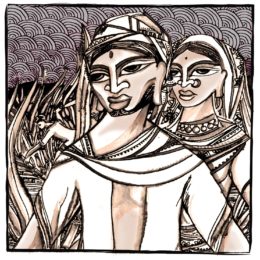Step back in time to the seventeenth century and discover the history and intrigue of St Nicholas Abbey, one of the oldest working sugar plantations on the island of Barbados.
With its cookie-cutter façade and meringue-tipped motifs that rise above the roof, this is one of only three surviving Jacobean buildings in the entire western hemisphere. Surrounded by gardens, the back of the house, with its stamped brick patio, looks over a slice of a sloping tropical forest with cabbage palms and eerie silk cotton trees.
The drive is also noteworthy, for its sweeping ocean view past the “Platinum Coast” – the very rich side of Barbados – and up to the breathtaking view of Cherry Tree Hill with its panoramic view of the Atlantic. Archaeologists have gathered many Amerindian artefacts from this area.
A trip to St Nicholas Abbey is a fascinating glimpse into Barbados’s history, a relaxing drive that showcases this small island’s variety of interesting geography, and a rare view of an architectural wonder that has survived nearly four centuries.
The Dutch-influenced Jacobean style of St Nicholas Abbey became popular in England from 1600 – 1690, during the reign of James I and Charles I. The furnishings of the abbey reflect the eras of various previous owners. The home is furnished with antiques, including a gentleman’s reading chair with attached tray and footrest. A list of the plantation’s slaves in the 1800s and their monetary value can be viewed, along with displays of art and jewellery.
Pedigree of a plantation
In 1658 Colonel Benjamin Berringer, a wealthy aristocrat, built this plantation house in the hills of St Peter. To the south, John Yeamans, Berringer’s partner in real-estate speculation, owned the Greenland plantation. Yeaman and Berringer bickered over the boundaries of their property, 365 acres in total.
Rumour has it that the two also competed for the affection of Berringer’s wife, Margaret. After a heated argument in 1661, Berringer left the plantation and headed to the bustling seaport of Speightstown – where he died. The rumour mill claimed that Yeamans and Margaret had poisoned him.
Subsequently, Yeamans’ political career thrived and he was even rewarded for his loyalty to King Charles II with 48,000 acres of land in the Carolinas, a British colony in what would later become the US. Yeamans returned to Barbados, however, after a disastrous stint at governing the Carolinas.
Sir John Gay Alleyne added the triple-arcaded portico, sash windows and Chippendale staircase. He converted Cherry Tree Hill to a grove of mahogany trees, which still stand today, and introduced the windmill-operated rum distillery that would become the foundation of St Nicholas
Abbey’s legacy.
The house continued to change hands, while several absentee owners employed overseers to run the plantation. During the Napoleonic wars in the early nineteenth century, the owners of the plantation could not even be located, and so the Chancery Court in Bridgetown took over in 1810.
Architect Larry Warren and his wife Anna purchased St Nicholas Abbey in 2006 and have opened the house for public viewing so that visitors can experience a slice of Barbadian history, preserved for posterity.
In store for visitors
A guided tour of the premises is included in the admission price of Bds$30, but visitors are welcome to take a leisurely stroll through the ground floor, the museum, steam mill and distillery.
The grounds surrounding the working facilities reflect the herb gardens of the seventeenth century. Hibiscus, orchids, roses, citrus fruit, mango, avocado and breadfruit trees are perfectly coiffed in a most regal manner. The serene silence is broken only by the sound of birdsong, with Guinea birds and green monkeys chattering and hooting their claims to the lush forests. In the courtyard, Lance and Baby, Moluccan cockatoos, stand guard.
New arrivals are treated to a rum punch or fresh fruit juice and a sample of the estate rum, a smooth, almost brandy-like rum that has been aged for at least ten years. Made from the estate’s sugar cane, still harvested by hand, St Nicholas Abbey Rum is barrelled in oak bourbon casks that are aged in the old stables. Each year a select reserve is stored away, and all proceeds from this aged rum, which aids in qualifying St Nicholas Abbey as a heritage site, are used towards preserving the plantation.
While in Barbados, Debbie Jacob stayed at the family-owned, oceanfront Rostrevor Hotel, conveniently located in St Lawrence Gap, the heart of Barbados’s nightlife. The hotel features air-conditioned efficiency-apartment-style rooms: a kitchen, a terrace that overlooks the sea, cable TV, and wireless Internet. There’s a pool and access to a stretch of beach mere feet from the hotel rooms.






















